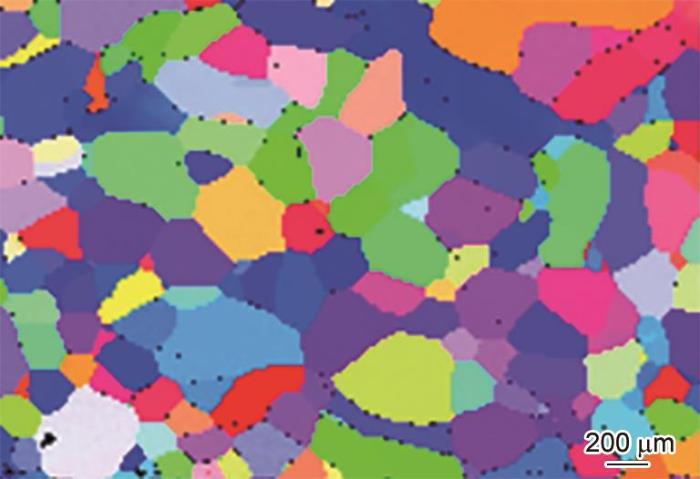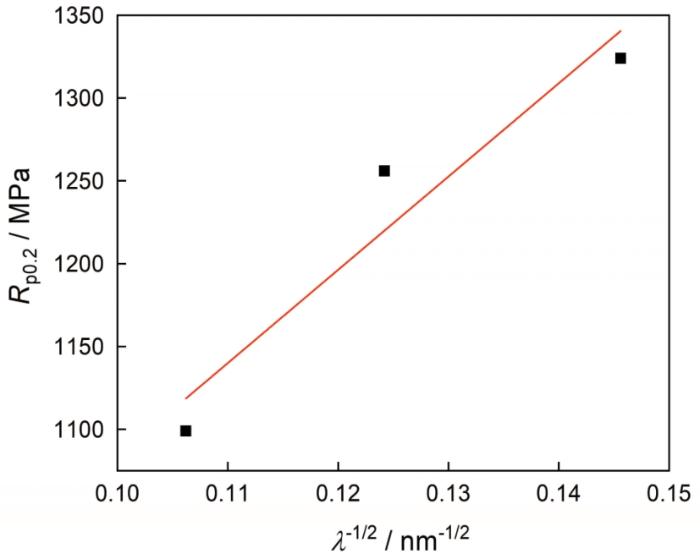关于热处理后亚稳β钛合金的组织、强度和塑性,已经有大量的研究工作[10]。Li等[11]发现,经过850℃/1 h固溶处理和500℃/2 h单级时效处理的Ti-2Al-9.2Mo-2Fe合金强度最高,其抗拉强度为1543 MPa,达到了超高强钛合金标准。Zheng等[12]的研究发现,固溶+双级时效处理也能大幅度提高亚稳β钛合金的强度。在预时效阶段析出的ω相在二次时效阶段促进次生α相形核,进而生成更加细小弥散且分布均匀的次生α相,从而使合金的强度提高。马权等[13]对TB8合金进行固溶+双级时效处理后发现,次生α相明显细化使合金抗拉强度的提高超过了17%。Zhou等[14]则发现,与其他热处理工艺相对,固溶+随炉冷却处理也能显著提高合金的力学性能,生成枝晶状生长的α相实现了强度与塑性的良好匹配。这些结果表明,固溶+单级时效处理、固溶+双级时效处理、固溶+随炉冷却处理等不同的热处理工艺,对亚稳β钛合金析出的次生α相及强度和塑性产生不同的影响。
Ti-6Mo-5V-3Al-2Fe-2Zr (%,质量分数)合金是一种新型的亚稳β钛合金,基于Mo当量准则和d-电子成分设计方法设计,其Mo当量为12.15,Bo、Md值分别为2.7823、2.3765。作为一种新型亚稳β钛合金,热处理工艺对其组织、强度和塑性的影响尚不十分清楚。鉴于此,本文对该合金分别进行固溶+单级时效处理、固溶+双级时效处理以及固溶+随炉冷却处理,研究热处理工艺对Ti-6Mo-5V-3Al-2Fe-2Zr合金的次生α相以及强度和塑性的影响。
1 实验方法
实验用材料为亚稳β钛合金Ti-6Mo-5V-3Al-2Fe-2Zr (%,质量分数)。将高纯海绵钛、Al-Mo中间合金、Al-V中间合金、纯铁和海绵锆经过两次真空自耗熔炼,得到直径为12 mm的亚稳β钛合金Ti-6Mo-5V-3Al-2Fe-2Zr (%,质量分数)铸锭,对其在β相区锻造得到合金板材。用电火花线切割在板材上切取实验用试样。
采用公式法和金相法测定该合金的相变点。根据加入不同合金元素后合金相转变温度的变化估算合金的相变点 [15]
式中的882℃为纯钛的相转变温度,fi (xi )为合金中各元素对相变点的影响值。使用
将切取的试样分别进行固溶+单级时效处理(HT1)、固溶+双级时效处理(HT2)和固溶+随炉冷却处理(HT3),热处理工艺在图1中给出。
图1
图1
合金的热处理工艺
Fig.1
Heat treatment process (a) solution and single-stage aging; (b) solution and two-stage aging; (c) solution and furnace cooling
是用Nordlys Nano型EBSD探测器观察和分析电解抛光后试样的晶粒尺寸和析出相 (抛光液为6%高氯酸+35%正丁醇+59%甲醇),步长为0.04 μm。使用腐蚀液(氢氟酸∶硝酸∶水=1∶3∶7)腐蚀经过金相砂纸打磨、机械抛光后的合金试样表面,用S-3400N型扫描电子显微镜观察试样的显微组织。使用WDW-100型电子万能试验机分别对三种热处理后的试样进行室温拉伸实验,以测定其拉伸性能,计算其抗拉强度、屈服强度以及断后伸长率。使用S-3400N型扫描电子显微镜观察断口形貌,分析其断裂形式。
2 实验结果
2.1 显微组织
图2给出了热处理前Ti-6Mo-5V-3Al-2Fe-2Zr合金的EBSD图像,可见其组织全部为β相。
图2
图3给出了经过不同工艺的热处理后Ti-6Mo-5V-3Al-2Fe-2Zr合金的显微组织。由图3a和3b可见,经过HT1处理后在β晶界处生成了连续的晶界α相(αgb);在β晶粒内析出了短棒状次生α相(αi)。由图3c和3d可见,经过HT2处理后在β晶界处也生成了连续的αgb相,但是在β晶粒内析出的αi相数量更多且大部分尺寸较小。其原因是,在预时效阶段生成的ω相在后续高温时效阶段促进αi相的形核从而生成了细小弥散的αi相[18~21]。但是,由图3d可见,一些优先形核的αi相在后续高温时效阶段充分的生长而使部分αi相长大而粗化。由图3e和3f可见,经过HT3处理后在β晶界处生成了由αgb相形核并向晶内平行生长的αwgb相,在β晶粒内析出的αi相由短棒状变为针状,宽度明显减小且间距变窄。
图3
图3
不同热处理后合金的显微组织
Fig.3
Microstructure of the alloy after different heat treatment (a) HT1, grain boundary; (b) HT1, intragranular; (c) HT2, grain boundary; (d) HT2, intragranular; (e) HT3, grain boundary; (f) HT3, intragranular
图4给出了经过不同热处理的合金的EBSD图像。图4a、b、c的解析率分别为96.23%、96.12%和95.56%,三者的解析率较高且差异较小。用EBSD进一步分析了次生α相。结果表明,经过HT1、HT2、HT3处理后合金的β晶粒内析出的αi相尺寸逐渐减小,且在β晶界处均生成了连续的αgb相;与HT1和HT2相比,经过HT3处理后合金的晶界处生成了αwgb相,与图3中合金的显微组织相同。用EBSD统计次生α相(αs)的体积分数φ(αs)并结合图3统计αi相的平均间距λ,结果列于表1。可以看出,不同的热处理使αs相体积分数变化的趋势为,HT2>HT3>HT1;αi相平均间距的变化趋势为,HT1>HT2>HT3。
图4
图4
热处理后合金的EBSD图像
Fig.4
EBSD images of the alloy after different heat treatment (a) HT1; (b) HT2; (c) HT3
表1 热处理工艺对αs相体积分数和αi相平均间距的影响
Table 1
| Heat treatment | φ(αs)/% | λ/nm |
|---|---|---|
| HT1 | 34.8 | 88.75 |
| HT2 | 40.3 | 64.85 |
| HT3 | 37.5 | 47.15 |
2.2 合金的拉伸性能
合金经过不同工艺的热处理前后的屈服强度(Rp0.2)、抗拉强度(Rm)、断后伸长率(A)和强塑积(Psp),列于表2。可以看出,经过三种工艺的热处理后合金的强度都大幅度提高;与HT1处理相比,HT2热处理使合金的屈服强度和抗拉强度提高,断后伸长率由5.1%降低为4.8%,合金的塑性没有明显的变化;HT3处理后合金的屈服强度和抗拉强度进一步提高,其断后伸长率也明显提高;在三种热处理中,HT3处理后合金的强塑积最高,为10.94 GPa%,其强度与塑性匹配最佳。
表2 热处理对合金拉伸性能的影响
Table 2
| Heat treatment | Rp0.2/MPa | St.dev | Rm/MPa | St.dev | A/% | St.dev | Psp/GPa% |
|---|---|---|---|---|---|---|---|
| Before HT | 784 | 9 | 891 | 10 | 9.1 | 0.22 | 8.11 |
| HT1 | 1099 | 22 | 1196 | 26 | 5.1 | 0.17 | 6.10 |
| HT2 | 1256 | 19 | 1352 | 21 | 4.8 | 0.21 | 5.68 |
| HT3 | 1324 | 13 | 1421 | 11 | 7.7 | 0.13 | 10.94 |
2.3 合金的断口形貌
图5
图5
不同热处理后试样的拉伸断口的形貌
Fig.5
Fracture morphology of tensile specimens after different heat treatment (a) HT1; (b) HT2; (c) HT3
3 讨论
式中Rν为单晶摩擦应力影响项,Rss为合金元素于β基体的固溶强化影响项,Rgb为β晶界强化影响项,Rpb为初生α相与β基体的界面强化影响项,Rpcpt为次生α相析出强化影响项。对显微组织的观察结果表明,在本文的实验中未观察到初生α相,于是
根据
式中Rpcpt, exp为次生α相析出强化影响量,Rp0.2, exp为合金的屈服强度,Rν+Rss+Rgb的值则等于热处理前合金的屈服强度。由此计算出的Rpcpt, exp数值,列于表3。
表3 不同热处理后合金中次生α相的析出强化影响量
Table 3
Heat treatment | Rp0.2,exp /MPa | Rν+Rss+Rgb /MPa | Rpcpt,exp /MPa |
|---|---|---|---|
| HT1 | 1099 | 784 | 315 |
| HT2 | 1256 | 784 | 472 |
| HT3 | 1324 | 784 | 540 |
图6
图6
Rpcpt,exp与φ(αs )和λ的关系
Fig.6
Dependence of Rpcpt,exp on φ(αs ) and λ (a) the dependence of Rpcpt,exp on φ(αs ); (b) the dependence of Rpcpt,exp on λ
式中τ为位错运动施加的应力;τ*为αi/β界面产生的应力场,其值与位错源的位置以及界面能量有关,b为伯格斯矢量。
同时,堆积位错的数量可表示为[30]
式中v为泊松比;G为剪切模量。设位错源位于两个αi相之间,λ/2为位错的运动距离,则根据
式中k0为材料常数。
图7给出了不同工艺热处理后合金的屈服强度与λ-1/2的关系。可以看出,整体呈现出近似线性相关的关系,与
图7
4 结论
(1) 在三种工艺热处理的Ti-6Mo-5V-3Al-2Fe-2Zr合金的晶内析出了αi相,在晶界生成了连续的αgb相;与固溶+单级时效处理与固溶+双级时效处理相比,固溶+随炉冷却处理析出的αi相间距最小,且在晶界处生成了向晶内平行生长的αwgb相。
(2) 与固溶+单级时效处理及固溶+双级时效处理相比,固溶+随炉冷却处理的Ti-6Mo-5V-3Al-2Fe-2Zr合金强度和塑性匹配最佳,其抗拉强度为1421 MPa,屈服强度为1324 MPa,断后伸长率为7.7%。
(3) 经不同工艺的热处理后Ti-6Mo-5V-3Al-2Fe-2Zr合金晶内析出的αi相间距是影响其强度的主要因素,随着αi相间距的减小合金的强度提高;αwgb相的生成,使合金的塑性显著改善。
参考文献
Effect of C addition on microstructure and mechanical properties of Ti-V-Cr burn resistant titanium alloys
[J].The ingots with 120 mm diameter of burn resistant Ti-alloys with nominal composition of Ti-35V-15Cr, Ti-35V-15Cr-0.075C and Ti-35V-15Cr-0.15C were produced by vacuum arc consumable smelting. These ingots were deformed into bars with 25 mm diameter by sheathed extrusion. The microstructures of the ingots and extruded bars of burn resistant Ti-alloys were investigated. The tensile property, thermal stability and creep properties of the extruded bars of burn resistant Ti-alloys were tested under different conditions. The results show that burn resistant Ti-alloys with C addition have better ductility in tensile test due to refined grain size resulted from the sheathed extrusion process. Carbide can act as a stable sink for dissolved oxygen in the matrix, to improve the tensile ductility of the alloy even after hot exposure. In sum, the moderate C addition can improve the creep properties of burn resistant Ti-alloys.
C含量对Ti-V-Cr系阻燃钛合金微观组织和力学性能的影响
[J].用真空自耗熔炼制备了不同C含量的三种阻燃钛合金铸锭(直径120 mm),其名义成分分别为Ti-35V-15Cr、Ti-35V-15Cr-0.075C和Ti-35V-15Cr-0.15C。将铸锭包套挤压成直径为25 mm的棒材,观察了铸锭和挤压棒材的微观组织,测试并分析了挤压棒材的室温拉伸性能、高温拉伸性能、热稳定性能、高温蠕变以及持久性能。结果表明:添加C使阻燃钛合金热挤压后的晶粒显著细化,使其室温和高温拉伸塑性提高;由于碳化物的吸氧作用,添加C的合金热稳定性能显著提高;添加适量的C可提高阻燃钛合金的高温蠕变和持久性能。
Effects of heat treatment on microstructure, texture and tensile properties of Ti65 alloy
[J].Microstructure- and texture-evolution of Ti65 Ti-alloy plate were investigated, and the tensile deformation mechanism of the plate after heat treatment with different texture were discussed. The results show that heat treatment has a significant influence on the evolution of microstructure and texture of the plate. Equiaxed-, duplex- and lamellar-microstructure would be obtained after different heat treatment. The plate with equiaxed microstructure presented a B/T texture, while the c-axis of the α-phase and the rolling direction (RD) met at a 70°~90° angle; similar texture could be found in duplex- and lamellar-microstructure, meanwhile a new texture that the c-axis of the α-phase paralleled to RD could be found in the alloy. Room temperature tensile strength of plates with duplex microstructure could be enhanced by the dislocations and sub-structures, while had little effect on tensile properties at high temperature. Texture was found to be the main factor affecting the anisotropy of tensile properties of Ti65 plates, the plate would possess good tensile properties without obvious anisotropy in tensile strength after heat treatment of 980℃/1 h/AC+700℃/4 h/AC.
热处理对Ti65钛合金板材的显微组织、织构及拉伸性能的影响
[J].研究了不同热处理条件下Ti65钛合金板材的显微组织和织构的变化规律,分析了板材织构的类型和热处理影响拉伸强度的机制。结果表明,热处理对板材的显微组织和织构类型具有显著的影响。通过热处理可分别得到具有等轴组织、双态组织或片层组织的板材。等轴组织板材的织构为晶体c轴与板材RD方向呈现70°~90°夹角的B/T型织构,双态组织和片层组织板材的主要织构类型与等轴组织类似,且出现晶体学c轴与RD方向平行的织构。双态组织板材内的位错和亚结构使板材的室温拉伸强度提高,但是对高温拉伸变形的阻碍能力有限。板材中的织构是影响合金力学性能各向异性的主要因素。经980℃/1 h/AC+700℃/4 h/AC热处理后的板材横、纵向拉伸强度的差异最小,且都具有较高的室温拉伸性能和最佳的650℃拉伸性能。
Effect of second phase precipitation on martensitic transformation and hardness in highly Ni-rich NiTi alloys
[J].
Kinetics of dynamic recrystallization of TB6 Ti-alloy during hot compressive deformation at temperatures of β-phase range
[J].
TB6钛合金β区变形的动态再结晶动力学
[J].
High cycle fatigue properties and fracture behavior of Ti-5Al-5Mo-5V-1Cr-1Fe titanium alloy
[J].
Effect of heat treatment on mechanical properties of Ti-3Al-8V-6Cr-4Mo-4Zr alloy
[J].The effects of solution treatment and aging treatment on microstructures and mechanical properties of Ti-3Al-8V-6Cr-4Mo-4Zr alloy bars have been investigated. The results show that the highest hardness and the highest tensile strength can be achieved by the solution and aging treatment (800℃×30 min/AC+510℃×16 h/AC), and an insignificant decline on elongation rate and necking rate is also acquired. The quantity and size of the ω-phases and α-phases result in the increase of hardness and strength of Ti-3Al-8V-6Cr-4Mo-4Zr alloy bars. A lot of dimples exist in the tensile fractures of the hot rolling alloys and heat treatment alloysdemonstrating a typical ductile fracture.
时效处理对Ti-3Al-8V-6Cr-4Mo-4Zr合金力学性能的影响
[J].研究了固溶时效处理对Ti-3Al-8V-6Cr-4Mo-4Zr合金拉伸性能的影响。结果表明:在800℃/30 min+500℃/12 h处理后,合金的硬度和抗拉强度达到极大值,其延伸率和断面收缩率没有明显的降低。合金的硬度和强度的提高是ω和α析出相共同作用的结果。在合金的热轧态和热处理态的断口都出现了大量的韧窝,表明其为典型的韧性断裂。
Atomic-scale observations of B2→ω-related phases transition in high-Nb containing TiAl alloy
[J].
Effect of heat treatment process on microstructure and mechanical properties of titanium alloy Ti6246
[J].The influence of heat treatment temperature and cooling rate on the microstructure, phase and tensile deformation behavior of Ti-alloy Ti6246 alloy was investigated. The results show that the α′′ martensite was observed in prior β phase after solution heat treatment followed by water quenching. While a fine transformed β microstructure produced as a result of air cooling. For the air cooling alloy, both the size and volume fraction of the secondary α grain increased with the increasing solution heat temperature in air cooling samples. A “double yield” phenomenon appeared in the engineering stress-strain curves of the water quenching alloy samples. After aging treatment, the strength of water- and air-cooled alloys samples increased but the plasticity decreased. An optimal property in strength and ductility was achieved for the alloysamples after soluted solution treated at 900-920°C and then aged at 595°C.
热处理工艺对Ti6246钛合金组织与力学性能的影响
[J].研究了热处理温度和冷却方式对Ti6246合金显微组织、相组成以及室温拉伸性能的影响。结果表明:固溶热处理后合金的相组成主要与冷却方式有关。在β单相区及(α+β)两相区固溶后水冷,β相均转化为α′′马氏体和少量亚稳β相。空冷组织中的β相转变为含有少量次生α相的β转变组织,随着热处理温度的提高次生α相的含量逐渐增加,尺寸也逐渐增大。时效后组织中的亚稳相发生分解,析出细小的次生α相。固溶后水冷试样的拉伸曲线上出现“双屈服”现象,且随着固溶温度的提高合金第一屈服点逐渐升高。水淬和空冷合金试样在595℃/8 h时效后其室温拉伸强度提高,延伸率及断面收缩率降低,水淬试样室温拉伸性能的变化更大。固溶后空冷且在595℃时效处理的合金,其室温拉伸性能可达到较好的强塑性匹配。
Effect of solution temperature on microstructure and tensile properties of metastable β-Ti alloy Ti-4Mo-6Cr-3Al-2Sn
[J].
固溶温度对亚稳β钛合金Ti-4Mo-6Cr-3Al-2Sn的组织和拉伸性能的影响
[J].
Microstructure and mechanical property correlation and property optimization of a near β titanium alloy Ti-7333
[J].
Microstructural evolution and age hardening behavior of a new metastable beta Ti-2Al-9.2Mo-2Fe alloy
[J].
The indirect influence of the ω phase on the degree of refinement of distributions of the α phase in metastable β-Titanium alloys
[J].
Effect of double aging treatment on microstructure and mechanical property of TB8 titanium alloy
[J].
双级时效处理对TB8合金组织和性能的影响
[J].
Evolution of primary α phase morphology and mechanical properties of a novel high-strength titanium alloy during heat treatment
[J].
Accurate calculation of α+β/β phase transition of titanium alloys based on binary phase diagrams
[J].
基于二元相图精确计算钛合金α+β/β相变点
[J].
Effects of duplex aging on microstructure and mechanical properties of Ti-25Nb-10Ta-1Zr-0.2Fe alloy
[J].
双级时效对Ti-25Nb-10Ta-1Zr-0. 2Fe医用β钛合金显微组织与力学性能的影响
[J].
Effect of heat treatment process on microstructure and tensile properties of Ti-1300 alloy
[J].
热处理工艺对Ti-1300合金的组织和拉伸性能的影响
[J].
Role of ω phase in the formation of extremely refined intragranular α precipitates in metastable β-titanium alloys
[J].
Microstructure and properties of hydrogenated TB8 alloy
[J].
The role of ω in the precipitation of α in near-β Ti alloys
[J].
Evolution of secondary α phase during aging treatment in novel near β Ti-6Mo-5V-3Al-2Fe alloy
[J].
Microstructure evolution of ω and α phase of β-CEZ alloy during the solution treatment and aging process
[J].
β-CEZ钛合金在固溶时效时ω相与α相的组织演化规律
[J].
Effect of aging heat treatment on microstructure and tensile properties of a new β high strength titanium alloy
[J].
Microstructural tailoring and mechanical properties of a multi-alloyed near β titanium alloy Ti-5321 with various heat treatment
[J].
Influence of aging processing on microstructure and mechanical properties of Ti-10V-2Fe-3Al alloy
[J].
时效工艺对Ti-10V-2Fe-3Al合金显微组织和力学性能的影响
[J].
Tuning the scale of α precipitates in β-titanium alloys for achieving high strength
[J].
Processing-microstructure-yield strength correlation in a near β Ti alloy, Ti-5Al-5Mo-5V-3Cr
[J].
Effect of solution treatment and aging on microstructure and tensile properties of high strength β titanium alloy, Ti-5Al-5V-5Mo-3Cr
[J].
Microstructural dependence of strength and ductility in a novel high strength β titanium alloy with Bi-modal structure
[J].
Effect of heat treatment on microstructure and mechanical properties of a new β high strength titanium alloy
[J].
Evolution of microstructure and phase composition of Ti-3Al-5Mo-4.5V alloy with varied β phase stability
[J].The microstructure evolution and phase composition of an α + β titanium alloy, Ti-3Al-5Mo-4.5V (wt.%), have been investigated. Electron probe micro analysis (EPMA) quantitative results manifest that the stability of β phase decreases with increasing quenching temperature, which is influenced by the significant variation of β-stabilizing elements concentration. Detailed microstructure analysis shows that the β → ω phase transformation does occur when quenching at 750 °C and 800 °C. The ω-reflections change from incommensurate ω-spots (750 °C) to ideal ω-spots (800 °C) as the β stability of the alloy decreases. Further the decrease of β phase stability encourages the formation of athermal α′′ martensite, which has the following orientation relationships: [111]β//[110]α′′, [100]β//[100]α′′ and [-110]β//[00-1]α′′ with respect to the β matrix.
Effect of heat treatment on microstructure and mechanical properties of ultra-fine grained Ti-55511 near β titanium alloy
[J].
Effect of long term aging on the fatigue crack propagation in the β titanium alloy Ti 17
[J].












